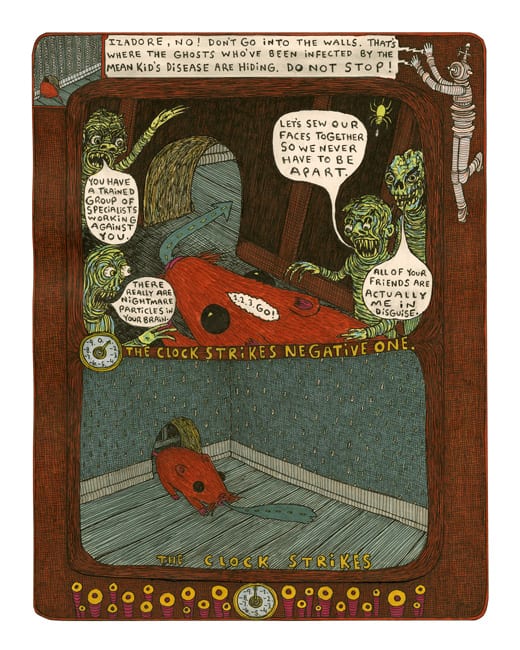In The Understanding Monster — Book One, artist savant Theo Ellsworth takes the ideas and images found in his excellent graphic novel debut, Capacity [Secret Acres, 2009], to an even more audacious and hallucinatory level. For the uninitiated, this could pose a challenge. Even Ellsworth fans will need to give it a careful, immersive reading. Which it deserves. Ellsworth’s artwork and themes put him in the same school as Jesse Moynihan [Follow Me, 2009], Jesse Jacobs [By This Shall You Know Him, Koyama Press, 2012], and Eamon Espey [Wormdye, Secret Acres, 2008]— cartoonists who traffic in bizarre, visionary themes and imagery. But he inhabits a unique niche, devoting himself to a weird melding of autobiography and surrealism. It’s very much His Own Thing. His primary subject continues to be the exploration of his creative process, filtered through a very personal cosmology populated with intricately designed robots, many-scaled animals, fierce demons, and other denizens of the id.
In Understanding Monster Ellsworth delves into the minutia of the minutia of his brain’s inner realms, worlds that often function in opposition: colliding, refracting, and splintering. The story depicts the struggle to link these prismatic worlds, to get them working in harmony. He casts the classic quest to Find Oneself in a mythic, phantasmagorical light.

Oh, there is a plot here: right at the outset our protagonist, Izadore, finds his spirit trapped inside a mouse’s body, while his “Phantom skeleton” calamitously roams free. He needs to escape from “negative time” and find his way back to his corporeal form to reintegrate his mind/body/spirit with the help of a fly, itself inhabited by another spirit, a spaceman called This Way That Way. In his quest, he’s aided by a host of benevolent creatures including one Inspector Gimble, who is his major guide and protector, a group of sentient toys and a green girl named Gill. Standing in his way, however, is a rogue’s gallery of antagonists ranging from the Devil to a pharaoh’s mummy to a group of terrible entities called the Mean Kids in the Walls.

The perilous quest Izadore undertakes in Understanding Monster continues Capacity’s exploration and deconstruction of the creative process: finding your true voice, fighting through the negative feedback loop, locating the core of the self, and manifesting it on the page or canvas as honestly as possible. All the characters guiding or opposing Izadore appear to be elements of his personality, with each faction fighting for dominance. The toys, for example, seem to represent those nagging voices inside our heads: the ones that hold us back, for our own good, to protect us from the terrible calamities that might befall us at any second. Sample dialogue:
Toy: I just realized that you have microscopic tribes of violent spore lords living on the surface of your eyeballs! One eye is at war with the other, and both sides have been using your brain as a nightmare particle factory and fueling their attack vehicles with your blood! What are you going to do?
Inspector Gimble: Again, ignore the toys for now.
(Obviously, the Inspector’s advice is the way to go.) Meanwhile, the Mean Kids more than live up to their name, representing bullies both internal and external, hurling a startling array of bloodcurdling threats of reprisal onto our hero: “I have the power to give people diseases just by looking at them, and I’m staring at you hard!” and “I’m making a TV show about your painful decline! It’s on right now!” Hearing that could give even the bravest of adventurers, the boldest of Argonauts, a shiver of fear.

Ellsworth conjures up a dizzying array of beautiful, intricately patterned, labyrinthine drawings, perfectly capturing the spiraling sprawl of the narrative within a narrative within a narrative. What keeps this soufflé from collapsing is this: no matter how bizarre the proceedings, Izadore’s odyssey always maintains its internal (il)logic. Somehow, Ellsworth manages to make a perfect sort of sense, and we root for Izadore to escape the forces aligned against him and complete his quest. Ellsworth’s deep imagination, as well as his idiosyncratic charm, humor, and sincerity are evident in every passage rendered, no matter how far out into the ether it may be. His trippy psychedelic home movies are projected directly from his head without ever forgetting the heart.
Up next in Book Two: Ellsworth promises to take us inside Toy Mountain, to Oracle Trance Class, and show us Pro-Level Exorcist Techniques! Count me in.







